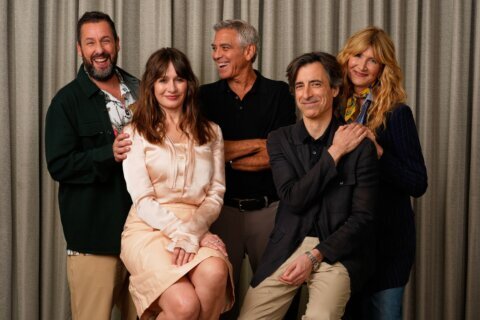WASHINGTON — Ahh, Katniss. We’ve come so far together. And now we’ve got to let you go.
“The Hunger Games” saga has been with us for the past seven years, starting with Suzanne Collins’ book trilogy from 2008-2010, and culminating with four blockbuster movies: “The Hunger Games” (2012), “Catching Fire” (2013), “Mockingjay: Part 1” (2014) and “Mockingjay: Part 2” (2015).
If you’ve loved every installment as a die-hard fan of the books, you’ll likely find the final flick an emotional conclusion recalling the time you turned the final page on this page-turning adventure.
But if you’re a casual viewer of the films only — Disclaimer: Yours Truly only read the first book before reviewing all the movies on their own merits — you’re likely feeling the seven-year itch, ready to break up with Ms. Everdeen after fond memories but recent realizations that it’s time to move on.
No doubt our lasting taste would have been sweeter if the franchise had wrapped with one epic three-hour “Mockingjay” instead of two separate two-hour versions. In our “Hunger Games,” it’s best to have one steamy, jumbo lump crab cake than two packed with filler, served over two years.
This isn’t your fault, Katniss. It’s the fault of a studio system that broke up your momentum. Surely, “LOTR: Return of the King” would not have won Best Picture if it were divided in half and released over two years. Here’s hoping the Blu Ray release reunites “Mockingjay Part 1 and Part 2.”
“Part 2” picks up right where “Part 1” left off, as Katniss (Jennifer Lawrence) nurses a bruised neck at the hands of ex-lover Peeta Mellark (Josh Hutcherson), who’s been brainwashed by tyrant President Snow (Donald Sutherland). Fellow love interest Gale Hawthorne (Liam Hemsworth) stands to benefit from her indecisive heart, but the chief focus remains on the rebellion to free Panem.
Rebel President Alma Coin (Julianne Moore) teams with Plutarch Heavensbee (the late Philip Seymour Hoffman) and Haymitch Abernathy (Woody Harrelson) to wage their final attack on Snow’s Capitol. They want the injured Katniss to remain on the sidelines to record propaganda pieces as the face of the rebels, but Katniss has her own ideas — and a rogue plan to kill Snow herself.
This culminating chapter has plenty of positive things going for it, from action sequences that are genuinely exciting to poignant themes exploring the power of media propaganda, the urgency of a refugee crisis and the uncertainty of power vacuums created by toppled dictators.
Director Francis Lawrence — who’s directed every installment except the first by Gary Ross — shows his chops within the biggest set pieces. There’s a palpable suspense as Katniss’ band of rebels infiltrates The Capitol with “Raiders of the Lost Ark” style booby traps, just as a sewer sequence offers the nail-biting friction of the dark spaceship corridors of “Alien.” If you think you’ve outgrown jumping in your seat, think again. The direction in these individual sequences is damn effective.
The film’s problems lie in the larger construction, faithfully hitting the book’s emotional beats but doing so with a forced approach that removes any organic quality from the relationships. The love triangle is filled with over-the-top embraces shouting, “Stay with me” and “Always!” Expect some giggles in the theater; not from blushing teens, but from adults rolling their eyes at the melodrama.
What’s more, there’s no real surprise as to who Katniss is going to choose in the Peeta-Gale dilemma. The movie wants us to speculate which way her heart will sway, but this ain’t Ingrid Bergman torn between Humphrey Bogart and Paul Heinreid. Here, it’s a foregone conclusion. It’s far too obvious.
While this B-Story love triangle is a bit predictable, the A-Story plot is frustratingly spotty.
It takes a while to get our bearings after being dropped midway into “Mockingjay” — I’d recommend re-watching Part 1 before heading into Part 2 — because this is hardly a stand-alone movie. We really want to go along for the ride, but confusing elements keep tripping us up along the way.
You can imagine the Q&A between readers of the book and watchers of the movie:
Q: Why is an unstable, dangerous Peeta permitted to tag along? A: It’s fleshed out in the book.
Q: Why are those weird creatures attacking? A: Those are Lizard Mutts. Didn’t you read the book?
Q: Is Act Three a dream sequence? A: No, it’s really happening. Trust me, it makes sense in the book.
And that’s the problem. We shouldn’t need to know the book’s back story to understand the movie.
The movie should work on its own.
Above all, we yearn for Katniss to be more involved in the action. Too often in this series, particularly lately, the screen goes black by an unexpected event, leaving us to wake up with Katniss in a hospital to be told all of the great rebel accomplishments that happened while she was unconscious. This can work from time to time as a change of pace, but during the saga’s climatic showdown between Katniss and Snow — the moment we’ve all been waiting for — we want Katniss driving the action.
Instead, we’re thrown for a loop with a big “nevermind” that renders a passive heroine.
Thus, we plunge into the film’s conclusion with confusion, bewildered by the sudden new world order. By the time we learn the truth in a greenhouse, we don’t feel the warm rays of an “oh my god” plot twist, but rather the suffocating heat of a manipulative moment that left the best stuff off screen.
This new reality does, however, allow Katniss a gratifying hero moment in the form of a major public decision. While her choice is satisfying in content, it’s predictable in presentation, robbing us of some fun edge-of-our-seat guessing as to how it’ll play out. To put it in archery terms, the shot is right on target in its moral conviction, but our expectations have too much time to dodge out of the way.
And so, we enter the film’s final moments wishing we could hit pause, run to the bookstore, grab a copy of “Mockingjay” and fill in the gaps that the movie rushes straight through down the stretch.
In spite of this, there’s a brief glimmer of hope that the film might stick the landing, offering pillow talk like Marge & Norm in the perfect final scene of “Fargo” (1996). You’ll cross your fingers and whisper, “Cut to black! Cut to black!,” knowing this is the perfect time to bow out with directorial finesse. Instead, we get an epilogue that may work in literature, but which feels tacked on in cinema.
As the end credits roll, we close the book on Katniss with an overall appreciation for the macro more than the micro. J-Law’s badass heroine has elevated “The Hunger Games” far above other young adult efforts, but her Oscar-winning talents have long outgrown the confines of this space. She herself feels cognizant of this in the film’s final moments, as Katniss perfectly describes our seven-year itch: “It’s become a little tedious after all these years, but I guess there are worse games to play.”

The above rating is based on a 4-star scale. See where this film ranks in Jason’s Fraley Film Guide. Follow WTOP Film Critic Jason Fraley on Twitter @JFrayWTOP.







